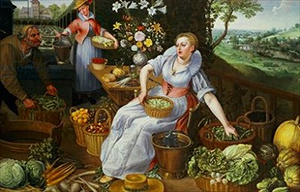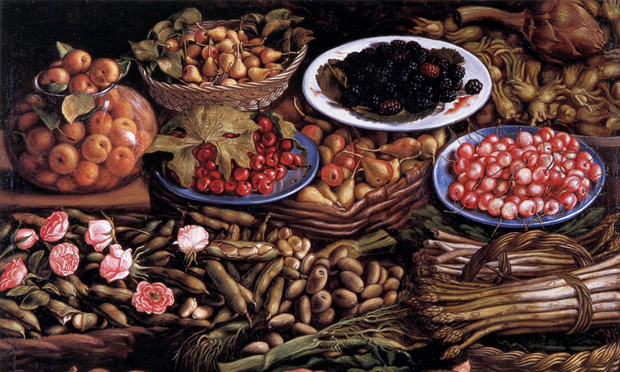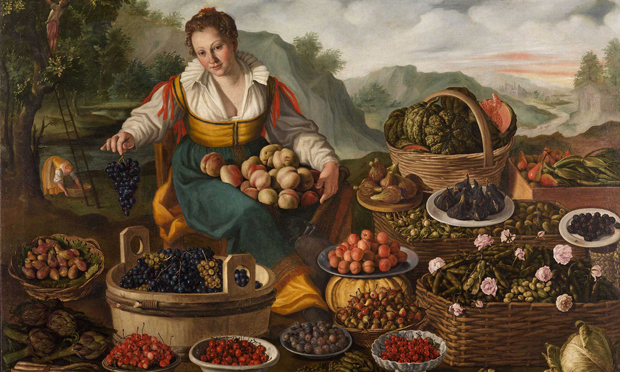Where have you bean? Gillian Riley with more on legumes, seeds and all manner of other pulchritudinous pods

Lucas van Valckenborch’s An Allegory of Summer, c. 1595
Fresh young peas and beans were a luxury in the late sixteenth century, as Lucas Van Valckenborch shows in Summer – one of a series of genre scenes of the four seasons.
A wilting young lady is mocked by an uncouth gardener as she toils away at shelling the huge basket of broad beans he has just delivered. Dried and cooked as food for the masses, broad beans were becoming an aristocratic delicacy, shown ready podded and strewn with rose petals in an earlier market scene by Vincenzo Campi (see below). Using them frozen saves us from wilting, but the tastiness of the dried beans is unbeatable. Chickpeas are even more versatile.

Still life of fruit, vegetables and roses (Natura morta di frutta, ortaggi e rose) by Vincenzo Campi
Hummus is almost the archetypal Hackney food, as we noted last month, available everywhere, comfortable with vegans or carnivores, and quickly made at home by the tired-woman-a-hurry, in an ‘I’m not as think as you drunk I am’ situation.
A jar of tahini (sesame seed paste) and some tins of chickpeas in the kitchen cupboard, and there you are, a tasty meal in few minutes. But there is so much more to these two ingredients. The chickpea, cicer arietinum, has been around for as long as mankind, and found in archaeological sites over 8,000 years old.
The Ancient Egyptians enjoyed them, and Cicero’s Rome made a sort of gastronomic pun on his family name (cicer is the Latin for chickpea, and arietinum means ram’s head, a nice way of describing its gnarled appearance).
Our hungry legionary, toiling up Stamford Hill towards Vindolanda, sniffed the Shoreditch air, and wondered if on his way back he could infiltrate his Ligurian aunty’s recipe for farinata, or socca as they called it up in Massilia (Marseilles, once a Greek colony), into the smoky Shoreditch scene.
A much-loved street food in Genoa today, farinata is made with chickpea flour, mixed with water and a little olive oil, and salt and pepper, left to ferment (ha, trendy, yes?) for a few hours or overnight, then beaten with some more oil, and cooked in big round metal pans in the intense heat of a wood-fired oven, to get a crunchy crisp outside and a soft layer within.
But we can all of us perform this miracle at home. Thanks to Fuchsia Dunlop, Hackney’s most distinguished food writer, I found out how to prevent the stuff from sticking to the pan, which was always my problem. Her succinct explanation of how to season and maintain a wok is the answer. [Every Grain of Rice, pp. 14 -16)]
For our pancake you heat a thick iron frying pan (no non-stick nonsense here) until the metal is seriously hot and discoloured, then swirl some light oil, grapeseed or peanut, around until the surface of the pan has taken up a protective coating, empty the pan, then tip in some fresh live oil and your pancake batter, and let it crackle away for a few minutes. Then (a bit tricky this) slide the pancake out onto a plate, and reverse it upside down into the still very hot pan, (do not attempt this barefoot) and let it cook for a while until crisp and brown.
Yes, it will fall apart as you cut it into wedges and remove from the pan, this is normal, but it will not stick. So carry on and make some more. These farinate have to be eaten at once, without any nonsense about fancy toppings and seasonings. The combination of plentiful good olive oil and the fragrant, nutty, slightly musty, chickpea flour is addictive, to be enjoyed on its own with salt and pepper, or like a flatbread with salads or whatever.

Vincenzo Campi’s Pinacoteca di Brera
It is a cheering thought that dried chickpeas were to be had in Vindolanda, and so maybe our friend, with his standard mess-kit of quern to grind them into flour, and iron frying pan to make the pancakes, could recall fond memories of Aunty, and dream of Ligurian sunshine and fish suppers.
The other ingredient in hummus is tahini, sesame paste, made from the seeds of a plant that has been around as long as chickpeas. These seeds stay inside the pods in which they grow until, at the moment of ripeness, they all pop out at once in a huge rush. So the expression ‘Open Sesame!’ in the tale of Ali Baba can be interpreted as the overflow of good things that answer the right call at the right time.
We find these magical little seeds all over in Hackney, often toasted and sprinkled on meat or fish as a last minute garnish, or giving crunch and little bursts of flavour to vegetable dishes. A generous coating on sinit, the small Turkish ring bread, contrasts with the sweetish dough inside the crisp crust.
But the most amazing impact comes from the use in Korean cuisine of toasted sesame oil. The beating heart of this publication faces the wonderful Longdan Vietnamese supermarket on Kingsland Road, and there diligent contributors can reward themselves with the best brand, Ottogi, with its bold yellow and red containers, a precious condiment, not something you cook with. (Their website shows this writer intrepidly researching the condiments section).
The other star of Korean cooking, doenjang, soybean paste, and a chilli version, kochujang, are similar to Japanese miso paste, but with more oomph. With these in your larder, and a pot of kimchi the simplest dish of rice and vegetables can astonish.
An oriental salad with sesame oil sprinkled over just at the moment of serving, has an amazing aroma that perfumes the room. Last month’s restaurant review, for Shep’s (also of Kingsland Road), shows the brilliance of the Korean influence on innovative young chefs in Hackney.
